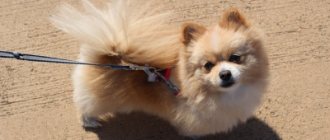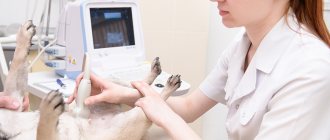Pregnancy in a dog lasts 60-62 days. However, viable offspring can be born at 58 days and up to 72 days. The gestation period varies depending on the breed of the animal. In large dogs and “pocket” dogs it can differ significantly.
Usually dogs give birth easily and humans do not need to interfere with the process. Difficulties can arise during the first birth and in very small dogs. In this case, you need to have the veterinarian’s phone number so that you can contact him if something goes wrong.
The birth of puppies for your pet is a great joy and, at the same time, responsibility. It is important to recognize the onset of labor.
Preparing for childbirth in dogs
What do you need to know about this? How to deliver a dog? Pregnancy lasts approximately 59-63 days. It will be easy to calculate the expected date if the day of mating is known.
Already two to three weeks in advance, you should begin preparing for the birth of puppies. This is when you need to contact a veterinarian if the owner plans to seek help from a specialist. It is also a good idea to find out the doctor’s number if the owner of the animal will deliver the baby himself. It cannot be ruled out that something will go wrong.
How long after mating do dogs give birth and how many puppies can there be in a litter?
A dog bears offspring for an average of 63 days. But everything is individual. The exact date of birth is difficult to determine. It depends on:
- female size - small breeds of dogs give birth earlier, at about 59-60 days (a Yorkshire terrier can give birth 57-58 days after mating);
- breeds Labrador, husky, German shepherd - these animals sometimes have long and difficult labor;
- number of puppies. In multiple pregnancies, labor occurs earlier and the process itself occurs faster;
- dog's age;
- complications that arise during pregnancy;
- number of previous pregnancies. Primiparous females often carry puppies to term.
In the last weeks of pregnancy
Any pregnancy in dogs is multiple. Each litter contains at least 2 puppies, 1 is born extremely rarely. Most often, 4-10 puppies are born. Their number depends on the breed and the number of fertilized eggs. Sometimes a multiple pregnancy, for example, an animal carries not 5 puppies, but 16, which does not correspond to its build, is a pathology. In this case, veterinarian intervention is necessary. He will also tell you how dogs give birth.
Bubble exit
How to arrange a place
Let's assume that the owner plans to personally deliver the dog's baby. What to do, how to properly prepare for this? You should start by arranging the place where everything will happen. This needs to be done in approximately 1-1.5 weeks. The animal will have the opportunity to get used to the new place.
How to arrange a “nest” for childbirth? You can take an old box that fits in size. Old magazines or books should be placed between the floor and the bottom, this will provide protection from drafts and cold. It is important that the dog fits freely in the box.
Visit to the veterinarian
After detecting the listed signs, make an appointment with a veterinary clinic. Plan a visit no earlier than a month after mating. By this time, relaxin, a sex hormone, will appear in the blood of the expectant mother, on the basis of which an interesting position is confirmed.
Determining the number of fruits
In addition to examination, palpation and blood tests, diagnosis involves ultrasound and x-rays. These procedures help determine the exact number and condition of the fruits, but not earlier than the beginning of the 2nd month.
Exclusion of pathologies
A visit to the veterinary clinic is recommended even if your four-legged pet is in good health. Not all pathologies are determined visually. Diagnostic procedures help to detect hidden complications and prevent their development.
What you will need
What else is needed to deliver a dog at home? A standard obstetric kit includes the following:
- box for newborn puppies;
- oilcloth and sheet;
- thermometers (medical and room);
- warmer;
- syringes, tweezers, pipettes, scissors;
- cotton wool;
- tray;
- gauze napkins;
- soft diapers;
- silk threads soaked in alcohol or vodka;
- watch;
- multi-colored woolen threads;
- small scales;
- notepad with pen.
Vaccinations, antiparasitic treatment and treatment during pregnancy
Vaccination is carried out strictly before mating, since the administered drugs can cause abnormalities in development or death of the fetus. Mother's immunity is transferred to babies during feeding and lasts up to 2-2.5 months.
Treatment against parasites is also recommended before mating, namely 14 days before the meeting of future partners. Anthelmintics are quite toxic, so they can negatively affect the health of puppies. Pregnant bitches are only allowed to take anthelmintic drugs if they are directly infected. In this case, the animal is given more gentle anthelmintics: Milbemax, Prazitel, Drontal Plus.
Any treatment is carried out only under the guidance of a veterinarian. The drugs are selected individually, taking into account their effect on the body of the expectant mother and her babies.
Where does it all begin?
Inexperienced obstetricians are not always able to identify the warning signs of childbirth in dogs. What are these “symptoms”?
- Discharge of whitish mucus from the genital tract. This can happen after sleep or when urinating. It can be assumed that there are 3-5 days left before contractions.
- Swelling of the mammary glands, leakage of colostrum when pressed. This indicates that there are 1-2 days left before contractions.
- The abdomen is noticeably balding. This primarily appears in the areas around the nipples. This also means that there are no more than 1-2 days left before contractions.
This is what the harbingers of childbirth look like in dogs. How can you understand that the process has already begun?
Author of the article: Kudryavtsev Vitaly Andreevich
12.04.17
Veterinary blog, For owners
Dear friends!
I am glad to welcome you to the pages of this site! Impromptu agenda today: childbirth in dogs in general and in dogs of dwarf breeds in particular. I would like to immediately make a reservation that there are quite a lot of articles of various kinds, textbooks on this topic, so I will allow myself to limit myself to a thesis statement that is most, in my opinion (as a veterinarian)
, something significant that can really worry an amateur dog breeder and something that should not be forgotten.
So, you and I remember that childbirth (eutocia) is a physiological process, for the sake of which both mating and subsequent pregnancy were started (which, by the way, can normally last from 56 to 72 days). How can we determine that a bitch is already giving birth? That is, in other words, when is it okay to worry? Indirectly, the duration of pregnancy and the approximate day of birth or the number from which you can really start waiting can be calculated by the date of mating, counting about 60-62 days. But this is usually true for bitches who have already given birth, when you know how long the pregnancy lasts for a particular dog. Of course, a necessary addition is visual diagnostics: ultrasound (starting from the 24-28th day of pregnancy) and radiography (from the 45th day of pregnancy). It should be clarified that we can reliably estimate the number of fetuses only by performing an X-ray examination. You can also carry out laboratory diagnostics: look at the level of progesterone (as a rule, it decreases significantly 10-14 hours before birth).
But first of all, you and I will focus on the so-called harbingers of labor or, in simple words, on the clinical signs of impending labor.
Such signs include:
- An increase in the volume of the abdomen as a result of an increase in the size of the pregnant uterus and relaxation of the pelvic ligaments and abdominal muscles. This sign is most relevant for dogs giving birth more than once, as well as for multiple pregnancies.
- Swelling of the mammary glands and swelling of the vulva. Indeed, in most dogs, the mammary glands swell immediately within 24-48 hours, increasing slightly in size. The appearance of colostrum before childbirth is not mandatory: colostrum can begin to be released during labor and after childbirth. Swelling of the vulva can, of course, serve as a sign as such and should only be considered in conjunction with others.
- Decrease in temperature. Stock up on a thermometer (preferably electronic) and, starting from the 60th day, take measurements periodically. It should be recalled that at the end of the 8th to the 9th week the temperature can “jump” within the range of 37.0 (37.5) -38.5°C. Somewhere 12 (rarely earlier) hours before giving birth, the bitches’ temperature “drops” to 37°C on average. Moreover, in large animals it is precisely up to 37°C, but in dwarfs it is up to 35°C.
- The presence or absence of appetite is not a reliable sign.
- Specific behavior in the period before childbirth: building a “nest”, actively digging a “hole”, anxiety. It is not a reliable sign, common to everyone: it very much depends on the conditions of the animal’s keeping, age, characteristics of the animal’s temperament and the level of contact with the owner.
What can be said about the precursors of childbirth is that all factors need to be assessed in a complex manner. And, of course, during the last 2-3 days (that is, starting somewhere from the 59-60th day), if possible, with the dog. In this case, you need to draw your attention while waiting for your dog to give birth to labor disturbances (dystocia). One of the first things you may encounter is abortion. The aborted fetus is very often eaten by a dog. If you are unlucky to encounter this, but lucky enough to discover an aborted fetus in time, then: it would be good to conduct serological studies of the bitch and bacteriological studies of the fetal membranes and stomach contents of the fetuses. If you didn’t see it and the bitch still ate everyone, then there will still be discharge (mucous and/or serous-mucous) and you won’t get any warning signs of labor (since it’s a pathological pregnancy), so the bitch should be examined. By the way, mummified fruits also occur, but rarely, and this happens, you need to be prepared for it.
A common problem is eclampsia-tetany as a result of hypocalcemia. Remember that these pathological processes can develop not only after childbirth, but also immediately before childbirth, in late pregnancy. The situation, as a rule, is typical: on the day, say the 50th, the bitch began to get very worried, it’s hard to breathe shallowly, drooling and tension in the skeletal muscles may also be observed. The cause is most often an unbalanced diet. By the way, an excessive amount of calcium supplements in the diet significantly reduces its absorption in the intestines, which leads to a lack of calcium in the body, because calcium transits through the intestines and is excreted.
Another point that it is better not to forget: if in the last stages the bitch suddenly has a discharge (profuse bloody, bloody-mucous, purulent, of a specific greenish, greenish-brown color) and an unpleasant odor (usually putrefactive) ), then you urgently need to make sure that the fruits are not dead. And if this happens, then urgently remove them from the uterus by a conservative method (ineffective, since with dead and decaying puppies in the uterine cavity, the dog’s body as a whole and the uterus in particular are little susceptible to the action of certain drugs due to increasing intoxication) or surgically. The main causes of intrauterine death of puppies and subsequent discharge are, as a rule, various infections and infestations. But injuries are not the least important. Remember, in later stages the bitch must be protected from injury. A pregnant bitch should, if possible, be kept separately.
Now let's mentally go back a couple of months: in order to understand what and how our pet will be born, it is necessary to at least briefly describe in what sequence and what processes occurred from the moment of fertilization to the actual birth. Fertilization of the eggs is completed in the oviducts, and there the already fertilized eggs pass through the stages of morula and 32-64 cell blastocytes. And then - migration to the uterus. About 16-18 (up to 20) days are allotted for everything. After this, the embryos are allowed a short vacation: no less than 3 days are given to freely swim in a special secretion in the horns of the uterus. Then the embryos must occupy the corresponding areas of the uterus... but the “babies” with a diameter of 2 mm do this very slowly - 3 days. When we talk about the corresponding areas of the uterus, it is assumed that we are talking about the endometrium, in which, a little more than 2 weeks after mating, localized areas of edema appear, located at the same distance from each other: this is for the embryos, so that they are comfortable and they are already attached. Only after their attachment can heartbeats be detected using ultrasound diagnostics. Once attachment is complete, the placenta begins to form. At this stage, the hematomas formed around the embryo form the blood vessels of the umbilical cord. The structural connection of the uterus and fetal membranes, the allantois and the amnion floating in it (containing the embryo) is formed on the 23rd day of pregnancy. So the 35th day comes quietly, and we will already be able to distinguish the bodies of the embryos. On the 40th day, the eyes of the fruit are covered with eyelids, there is fur, claws and even marks are visible. You can also already tell who is who: some are males, some are females. On the 42-45th day you can do an X-ray examination - the skeleton will be visible. And, as it turned out, there are only a little over 2 weeks until the birth.
No matter how experienced the owner of a bitch is, every birth is still an exciting process! No matter what anyone says, everyone is worried! Therefore, during childbirth, it is advisable to provide the bitch with the most comfortable and, above all, calm conditions. Of course, it’s better to give birth to a bitch together! It’s good for one too, but another pair of hands won’t be superfluous for sure. It would be good to take care in advance and have in stock: cream (fat content 22%), honey and coffee. Yes, it would also be good to wash/iron clean rags (and more), a couple of sheets, a couple of waffle towels (or maybe more) and boil some more or less cutting scissors in advance.
Attention! Medications should be administered only (ONLY!) by a veterinarian in accordance with the indications.
Childbirth, as is known, proceeds normally only if the fetus or fetuses are correctly positioned directly in the birth canal of the bitch. By what criteria can one judge whether it is normal/abnormal? So, the first is the position of the fetus: the ratio of the longitudinal axis of the fetal body to the longitudinal axis of the mother's body. There are: longitudinal, transverse and vertical. Naturally, the correct one is longitudinal. Then, the position of the fetus: the relationship of the fetus's back to the walls of the mother's abdomen. There are: top, bottom and side positions, and the top one is correct. Then it is also worth mentioning the presentation of the fetus: the relationship of the anatomical region of the fetus to the entrance to the pelvis. A puppy can “present” with anything: head, pelvis, etc., etc., but it is important for us to remember that cephalic and breech presentations are considered normal. And, finally, the position of the fetus - the position of the head, limbs and tail of the fetus relative to its body - let us immediately make a reservation that much in this matter depends on the presentation: with the head, everything should be in a straightened state, with the pelvic - the head and forelimbs are bent.
Childbirth itself can be divided into 3 stages, with the last 2 being repeated at the birth of each puppy.
The first stage (most often called preparatory) normally lasts from 6 to 12 hours. But it is important to remember that it can easily last all 36 hours, especially such delays are observed in primiparous bitches. But! Don't forget about thermometry, the temperature should remain low. The first stage is characterized by relaxation of the vagina, opening of the cervical canal and strong, but subtle (or unnoticeable) contractions of the uterus (contractions).
Other things to mention: restlessness, shortness of breath, licking of the vulva, possibly defecation and frequent urination. There may even be vomiting. This is normal, no need to worry. Remember, any stranger who comes now is, as a rule, undeniable harm. I want to emphasize two points: everything is proceeding as described (that is, normally) and then a stranger comes - then any visit is harmful! If you see that the dog, although worried, does not show excessive fear, does not howl, there is no profuse bleeding (namely blood), brown or purulent discharge (and at the same time the dog lies like a “rag”, with a temperature below 350C), then keep calm.
So, thanks to the contractions of the uterus, the puppies move further and further towards the pelvic cavity. As soon as the first of them reaches it, more violent contractions of the uterus begin, the abdominal muscles join them (pushing) and the second stage of labor begins, which lasts on average from 3 to 12 hours (rarely it lasts up to 24 hours). How can we additionally determine that the second stage has already begun? Oh, this is interesting: when the fetus enters the birth canal, the chorio-allantoic membrane ruptures, which is accompanied by an abundant flow of clear fluid, that is, the discharge of amniotic fluid. After the water breaks, it can take up to 4 hours for dogs to give birth to their first puppy. Rectal temperature rises to normal. You may not see the proverbial waters, so it is useful to remember that any of the above signs indicate the onset of stage 2. Speaking about pushing, it is appropriate to recall the so-called Ferguson reflex, that is, irritation of the vaginal wall by the presenting parts of the fetus, in response to which pushing appears.
Thus, 5-10 powerful attempts and plus contractions, and the amnion and paws appear, the head and limb girdles erupt, in other words, the fetus is expelled. This is normal, that's all. All about everything in about 5-7 minutes. But you must remember that if the bitch has strong attempts for 20-30 minutes, and no one is born, you will have to consult a doctor, it is unlikely that you will be able to help with anything. Summarizing everything that has been written about the second stage, you should worry in cases where: uncharacteristic, heavy discharge instead of transparent (most likely, labor will be hampered by a dead fetus); the waters broke, 3-4 hours passed, and no one was born; weak attempts for more than 2 hours, but no one wants to be born, or, on the contrary, very strong attempts for more than half an hour with the same result; the first puppy was born, more than two hours passed, and no one else appeared, and palpation (and/or using laboratory diagnostics) reveals more puppies; the second stage itself lasts more than 12 hours.
The first and subsequent puppies are born: don’t wait for anything, break the birth bladder yourself, clean the muzzle of the fetal fluid with a sterile napkin, cut the umbilical cord yourself. As a rule, it is not necessary to apply a ligature to the umbilical cord in small and toy breeds, but in medium and large breeds it will be necessary. In general, it is better to have a clamp for these purposes. It is usually best to cut the umbilical cord at a distance of about 1 cm from the abdominal wall. It would be good, before placing the puppy under the bitch, firstly, wipe it with a hard (preferably waffle) towel (in this way, you seem to imitate the bitch licking the puppy, and this is needed to stimulate the newborn’s blood circulation), and secondly, turn the puppy down head (wrapping it in a towel, otherwise it will slip out), shake it thoroughly a couple of times and noticeably pinch it at the withers (just don’t overdo it too much), so that the baby not only shows all the signs of life, but also screams properly (clearing the upper respiratory tract, if You never know if you swallowed enough amniotic fluid).
If there are more than one puppies, then you have a box or ditch prepared for this case, lined with a clean, ironed sheet with a hot heating pad wrapped in flannel (or something similar). When you have done all the manipulations with the puppy, let the bitch lick it, squeeze out a little colostrum from the nipple and attach the puppy to it. Sucking the bitch's puppies also stimulates the production of colostrum and subsequent labor.
Be sure to count your afterbirth! There should be as many of them as there are puppies. I would not recommend giving them to a bitch to eat: there is still not much benefit from them, but the harm can be significant.
When describing the process of normal childbirth, you should also mention pathological childbirth and your actions in this case. Let me make a reservation right away: in this case, we will consider childbirth—not the pathologies of pregnancy. So, we need to immediately define what we are going to talk about: complicated (pathological, you can find this and that in the literature) childbirth or the inability of a bitch to expel fetuses through the birth canal without outside, preferably medical, help is called dystocia.
It is worth mentioning that, after all, problems with childbirth are not a common problem. According to the British Association of Veterinary Practitioners, in about 5% of 100 you and I may encounter them. Of course, there are also breeds from, so to speak, a risk group - these are brachycephalic breeds, that is, with a large (often not very proportional) head, which theoretically should have difficulties much more often. Dystocia occurs in all breeds without exception, occurs at different ages, and does not always depend on whether the dog has given birth before, and whether its mother and other ancestors had problems with childbirth. But first things first. First, let's check what stage of the birth process is now (?), and has the second stage begun (?), and have we panicked too early? Most often, it turns out that there would be something to make a fuss about... Although we talked about this, let's repeat a few important points: the second stage of labor begins when the waters (amniotic fluid) break, body temperature rises to the physiological norm (measured rectally - that is, using a thermometer inserted into the rectum), pushing began.
So, the main one is the second stage of labor. It would be good to establish the approximate number of fruits by palpation. This is not easy to do. But it is possible. Which means it’s necessary! Having put on a disposable glove (we’ll add it to your list of essentials) and additionally treated with an antiseptic (chlorhexidine bigluconate is perfect - we’ll also add it to the “Must buy!” list), you need to conduct a digital examination of the vagina to see if the cervical canal has fully opened and, if so , is there a puppy in it? Indirectly, the opening of the cervical canal and the activity of the myometrium (muscular layer) of the uterus can be judged by the state of the vagina (or rather by its tone) and the nature of the discharge, but it seems to me that this is all too relative. It is ideal to make sure that everything is fine with the puppies using an ultrasound. Let's make a reservation that on an x-ray we will try to see the accumulation of gases around the fetus/fetuses (the fetus has been dead for more than 6 hours) and the destruction-curvature of the spine and skull (the fetus has been dead for more than 48 hours). We try to detect a heartbeat using an ultrasound. It would also be good to calculate your heart rate (HR): if it is less than 180 beats per minute, then things are bad.
So, you need to run somewhere in cases where (we repeat again): the temperature has risen, but labor has not begun; you saw green discharge, but the puppies were never born; no contractions (more than 2 hours); or no pushing (similar to contractions); both in excess (more than half an hour); general signs of deterioration of the condition (that is, the bitch lies like a rag and stares indifferently “into emptiness”).
So why might labor not begin or... not continue on time? As a rule, most often breeders are faced with weakness of labor. When they talk about weakness of labor, they mean either primary weakness, the causes of which are: obesity of the bitch, a very large litter, a very small litter, very large puppies, poor nutrition; or secondary weakness (its causes are, as a rule, a categorical refusal of the uterus to work for a simple reason: tired). Secondary weakness manifests itself after a fairly rapid onset of labor, but then, then everything stops. Often due to obstruction (complete or partial blockage of the uterus due to improper placement of the fetuses in the birth canal or their death). It is easier to deal with primary weakness; you need to jog/walk the dog - that is, active movements, as well as massage the vaginal vault (that is, imitation of the Ferguson reflex, which I already wrote about).
But if suddenly it doesn’t help, then therapeutic or surgical assistance is necessary to treat primary and secondary weakness.
In addition to birth weakness, a possible cause of problems in a bitch giving birth can be: most often, narrowness of the pelvic canal (very bad when combined with laxity of the abdominal muscles); uterine torsion/rupture; aplasia (absence) and/or hypoplasia (underdevelopment) of the uterine horns (rare); various neoplasias (tumors) and fibroses (overgrowth of connective tissue) are even less common. You can also add prolapse of the uterus under the skin to this, but this can be easily prevented if you check in advance whether the dog has an inguinal hernia (and, if so, then operate in advance). As they say, everything needs to be done on time.
Speaking about the causes of problems during childbirth, we only mentioned the reasons associated with the bitch. “What else can prevent puppies from being born?” - you ask. The answer lies on the surface - the puppies themselves. Firstly (and what is most common), this is the incorrect position of the puppy: this includes breech presentation (normal, but only with the cervical canal completely open) or the so-called breech presentation - also breech, but the hind limbs are bent to the stomach; deviation of the fetal head downwards or to the side (this is a very problematic position of articulation: inserting a finger into the vagina, you find, as a rule, only one front paw - that’s all. Do not pull this paw under any circumstances, you will not pull anything out, the head is turned to the side plus the second paw will get in your way, but the puppy's paw, which you are diligently pulling, will come off and, if not completely, then you will definitely tear off the fingers. You need to, at all costs, turn your head with your finger and pull up the other paw. Once again - for one - don’t pull! If it doesn’t work out and you see that contractions/pushes are actively going on, and the puppy is “standing” and you can’t turn him around - don’t waste time - you need to save him and the unborn (if there are any), so surgical help is necessary in the form of a cesarean section. And if a paw is torn off, then you can try to remove the obstacle in parts. The same manipulations should be undertaken in situations where the fetal front paws are directed backwards or the transverse position of the fetus is “detected” (groped). However, in the case of a transverse situation - very rarely something works out, it is better not to waste time and operate immediately. If two fetuses meet in the birth canal at once, then you need to try to push one away. If he resists and does not push away, then definitely cut!
When correcting the position of the fetus with your second hand, be active: additionally fix the puppy through the rectum (this is especially true for owners of dwarf breeds, where sometimes, not only several fingers, but a little finger cannot be inserted). So, as the puppy passes through the pelvic joint (the perineal region is characteristically bulging), help yourself and the puppy through the rectum. It is important to synchronize your actions with contractions and further stimulate pushing. This is where a third hand comes in handy! You will need an assistant who supports the bitch under the forelimbs with one hand, and massages the abdominal wall with the other hand, thereby stimulating the appearance of more active attempts. You, having fixed the puppy through the wall of the rectum, try to correct its position and position with the finger of your other hand, and as soon as everything is corrected, wait for contractions/efforts, additionally massaging the vaginal vault, trying to fix the puppy with at least something. They pulled it up, secured it and pulled it out.
If the large fruit does not fit through the pelvic joint, we return to the sad thing - cutting again. Often the size of the puppy does not correspond to the diameter of the bitch’s birth canal, because there may also be deformities in the puppy itself. It may already be dead and swollen (with gases in the amniotic sac). May be stillborn and with hydrocephalus. If there is a suspicion of fetal death, it is necessary to cut. And don't wait for anything!
If we happily avoided pathologies and the third stage of labor ended with the expulsion of the placenta (placenta), then it is still too early to relax... Remember that lochia - postpartum discharge containing remnants of the placenta and amniotic fluid, is observed for 3 weeks or more. Lochia is most abundant during the first week and has a greenish tint. But you need to worry if: not all the placenta came out within 4-6 hours after the birth of the last puppy; lochia contains pus and has a putrid odor; the temperature has risen sharply and lasts for a long time (above 39.5°C); heavy bleeding from the vulva (not slightly pinkish spotting, but blood); The bitch's condition deteriorated sharply. Childbirth that lasts more than 24 hours is dangerous for the mother and her puppies!
Hope everything went well for you! If there is still EVERYTHING to come, I sincerely wish you GOOD LUCK! Don't be afraid of anything - everything will be fine!
Signs of the onset of labor
The “symptoms” described above make it clear that the puppies will soon be born. What are the signs of labor in a dog?
- It all starts with a drop in body temperature. As a rule, it drops by one or two degrees.
- The pet's behavior changes dramatically. The dog experiences anxiety, which can manifest itself in different ways. The animal “digs” the floor, rushes from corner to corner, actively licks the genitals, does not leave the owner, and so on. All this indicates that there are approximately 12-24 hours left before contractions.
- What signs of labor are observed in a dog 3-5 hours before contractions? The pupils dilate, the heartbeat quickens, the animal trembles and breathes quickly.
- How to understand that there are 0.5-1.5 hours left before contractions? The dog hunches his back, often squats and urinates, but still walks.
Afterbirth
It is extremely important to keep a record of all the departed placenta: during the normal course of labor, the number of departed placenta should correspond to the number of puppies born.
It’s not common, but it happens that in the womb two puppies live and develop in the same bubble. If this happens, then the departed placenta should be twice the size of the usual one.
Too long (more than 5 hours) delay of the placenta is a pathology of childbirth.
All this sounds complicated and sometimes even scary, but you shouldn’t be afraid or worry: often the bitch herself, without your help, copes with everything perfectly, because all her generic behavior is dictated by instincts inherent in nature.
Size matters
Will the animal need the owner's help? Childbirth in large breed dogs usually does not require intervention. Such individuals are quite capable of resolving on their own. It should be taken into account that they usually give birth to fewer puppies than representatives of “compact” breeds. It is necessary to provide assistance to the animal only if the birth is too prolonged.
What can be said about childbirth in small breed dogs? They are also able to cope on their own. Little is required from the owner - accept the puppies, cut the umbilical cords. However, the birth process can also be delayed, resulting in the need for intervention.
Potential problems
There are breeds that are considered problematic in terms of childbirth. If your pet is one of these, it is better to agree in advance with a veterinarian to accompany the process. It will also be needed in the following cases.
- Dysplasia. The hip joint is underdeveloped, the musculoskeletal system is impaired.
- Heart diseases. Not necessarily from the woman in labor herself. It’s better to play it safe, even if there have been similar problems in your family. The first sign of cardiac failure is shortness of breath.
- Large litter. Six or more puppies are expected. The number of pups can be determined using ultrasound already 40-45 days after mating.
- Small breeds. Miniature individuals give birth more difficult, especially if this is the first litter.
- C-section. If previous pregnancies ended with surgery.
In addition, it is better to trust specialists if you cannot stand the sight of blood, are squeamish, or do not understand the mechanism of childbirth.
How to help?
What help can the owner provide? Intervention will be required if the mother does not free the puppy from the bubble in which it was born. This membrane prevents the baby from breathing, so it must be broken quickly. If after this the puppy does not begin to breathe or move, you need to remove the fluid from the nose and mouth.
Help is also needed if the dog does not bite the umbilical cord on its own. You should pinch the umbilical cord with your fingers at a distance of about 2-3 centimeters from the baby’s belly, make a second grab at the same distance, and then break it. To ligate the umbilical cord, you will need a silk thread soaked in alcohol; this is necessary when blood appears.
Releasing the puppies from the amniotic sac and cutting the umbilical cord
So, the first puppy was born, he is in his shell.
The first thing is to quickly release him from this bubble so that the puppy switches to pulmonary breathing. If the bitch herself begins to chew on the amniotic sac, then you should not interfere with her - just make sure that she does not inadvertently damage the puppy. But it may also be that the young dog does not burst the bubble - in which case you will have to do it for him. Gently break the bubble with your fingers near the puppy's face/over the head and remove it. During childbirth, sometimes the amniotic sac ruptures on its own.
Now you need to clear the puppy's mouth and nostrils of mucus and fluid.
.
This is done like this: take the puppy in your hands, fix the head and spine of the newborn, and now shake it from top to bottom; or gently grab the baby by the tail, lift him up and hold him upside down for a while. The puppy should start fidgeting and squeaking. Take the prepared rag/gauze/napkin and, with considerable care, wipe the baby’s mouth and nostrils from mucus, blow lightly into his mouth. The puppy breathes shallowly at first, but after a few seconds his breathing returns to normal.
You will understand that everything is fine with the puppy if he breathes evenly, wriggles in your hands, and is tight and dense to the touch.
If your actions do not bring results: the puppy is lethargic, does not cry, breathes heavily, with sobs, repeat everything from the beginning several more times. Next, provide the following assistance: placing the baby head down on your lap, begin to massage the chest. To do this, gently stroke the puppy's chest from top to bottom for several minutes. Repeat shaking the puppy, wipe the mouth with a soft cloth, and blow into the mouth. If the puppy was born without congenital pathologies, these manipulations will return it to its normal state.
If the puppy breathes through the mouth or does not breathe at all, if the baby was born without an amniotic sac and smeared with a green substance or blood, in these cases it is necessary to react quickly and immediately begin to suck out the liquid from the puppy’s respiratory tract through the mouth (see Complications during childbirth).
After the newborn puppy is released from the amniotic sac, the umbilical cord must be cut. Again, either you or the bitch can do this. Breeders do not have a consensus on who should do this. But in any case, the umbilical cord must be cut quickly; the newborn should not be allowed to crawl with an uncut umbilical cord - this can lead to the formation of an umbilical hernia in the puppy.
You cut the umbilical cord:
first, to avoid bleeding, carefully drive the blood in the cord towards the puppy, then pinch the umbilical cord with your fingers/sterile tweezers/harsh thread soaked in alcohol at a distance of 2-3cm from the puppy’s tummy and another 1-2cm from the previous place of compression . Using sterilized (sterilized, alcohol-treated, iodized) scissors, cut the umbilical cord between the pressure points, then either lightly treat the umbilical cord with iodine, or do nothing else.
You cannot tie the umbilical cord with a knot.
The mother bitch bites the umbilical cord:
if your dog is whelping for the first time, then it may be advisable not to trust her to bite the umbilical cord due to her inexperience: sometimes first-time bitches are very zealous: they either gnaw the umbilical cord until the puppy develops a wound, or simply handle carelessly puppy. Therefore, if a bitch chews the umbilical cord on her own, carefully watch how she does this, and, if necessary, control her actions: if you notice a similar tendency in a dog, try to distract her with something.
After this “puppy-mother” connection is broken, oxygen stops flowing to the puppy in the usual way, and the puppy finally switches to pulmonary breathing.
After these procedures, carefully examine the newborn
for various developmental anomalies:
- cleft lip;
- cleft palate, or cleft palate: we can talk about the presence of this defect if the puppy produces milk from the nose while sucking;
- obvious discrepancy between the lengths of the jaws relative to each other;
- fused fingers;
- obvious deviation from the breed color norm;
- absence of genital organs and others.
If puppies in the litter have such deviations, unfortunately, such puppies are discarded. The culling should be carried out by a specialist in the breeding work of your club.
It is very important during childbirth not to forget to write down the main points . Once the puppy is born, record the time of birth.
,
gender of
the puppy, its
color
and existing features in appearance, before sending the puppy to its mother, weigh it and write down the result
( weight ) , it is also very important to make notes about the passage of the placenta or its absence.
Make similar records after the birth of each subsequent puppy. If the born puppies have the same color, in order to distinguish them from each other, you can tie multi-colored threads around their necks. Naturally, this must be done extremely carefully, without tightening the thread too much. As it grows, it is necessary to change the threads to newer ones. If everything is fine with the puppy, it can be sent to its mother . She will begin to lick him - it is very important not to disturb her: firstly, by licking the amniotic fluid from the baby, the mother bitch receives the necessary signal to stimulate labor, as well as for the formation of maternal behavior, and secondly, licking is like accepting a puppy , recognizing him as your own. If you fuss for a long time or dry the puppy very thoroughly, the bitch may easily abandon him.
A dog can roughly turn puppies over with its nose - don’t be afraid, it is with these actions that a caring mother stimulates the puppies’ breathing, their blood circulation and intestinal activity.
As soon as the bitch has licked the puppy, you should start sucking ,
if the puppy did not do it on his own. This means that you need to help the puppy find its mother's nipple so that it begins to feed. It's simple: take the puppy in one hand, put your finger in his mouth, with the other hand gently press the nipple so that a drop of milk comes out, now replace your finger with the nipple. Maybe the puppy won’t understand what’s happening the first time - just repeat your actions and everything will work out. Usually, there are no problems with suction, except for deficiencies in the structure of the oral cavity.
It is advisable to help the puppy to attach to the mother's nipple as quickly as possible, since during sucking the bitch receives a signal to accelerate labor, as a result of which the dog's uterus begins to contract. Sucking plays an important role not only for the mother, but also for the puppy: milk entering the baby’s body stimulates intestinal activity, which leads to the release of the first feces (a sticky black substance). Only after the first bowel movement will the normal digestion process begin, therefore, the sooner meconium (1st feces) is released, the better. Sometimes weak puppies have problems with their first bowel movement, you will need to help them by gently massaging the puppy's belly and anus with a small cotton swab dipped in water.
The smallest
Miniature pinschers, chihuahuas, Yorkshire terriers and other representatives of the smallest breeds are not able to push puppies out of the birth canal on their own. In this case, owner intervention will be required. How to deliver a dog?
- When pushing, a fetal sac appears. The owner must seize the moment and secure the puppy in the birth loops. This must be done by holding the baby's head in the bubble. If the puppy is born feet first, you should hold it by the area above the hips. It is strictly forbidden to drag a newborn by the paws.
- When pulling babies out, it is necessary to do this in the direction of the birth canal. A careful and smooth “loosening” of the puppy from side to side is allowed.
Causes of labor
Childbirth is the result of a whole complex of reasons. Experts conditionally divide them into three groups. The first group is the reasons preparing for childbirth; the second - causing them and the third - supporting labor.
Experts include the following reasons for the first group:
A strong decrease in the excitability of the cerebral cortex, causing an increase in the activity of the subcortex and sexual center, a decrease in anti-contractile substances, an increase in the excitability of the neuromuscular apparatus of the uterus, an increase in the content of relaxin, which causes relaxation of the ligaments of the pelvis and its symphysis.
The reasons of the second group include:
Accumulation of highly active estrogens, against the background of a decrease in progesterone levels. This is facilitated, in particular, by impulses emanating from the fetus. Thus, as a result of activation of the function of the fetal adrenal glands, an increased amount of corticosteroids involved in the synthesis of estrogens and the release of prostaglandin (PGF2a) enters the placenta. Under the influence of prostaglandin, secreted by special cells of the placenta and endometrium, the function of the corpus luteum in the bitch ceases, and the level of progesterone drops.
With the participation of estrogens, a morphological and biochemical restructuring of the myometrium occurs (accumulation of contractile protein, glycogen, phosphocreatinine, calcium, etc.), the excitability and sensitivity of the uterus to mechanical (fetal movements), chemical (oxytocin, acetylcholine, serotonin, prostaglandins, etc.) increases. d.) and other irritants that affect uterine contraction. At the same time, the activity of the stimuli themselves increases.
The reasons of the third group include: the action of acetylcholine, which maintains the rhythm of the birth process, mechanical irritation of the paracervical and paravaginal ganglia, which reflexively cause contraction of the uterine muscles. Contractions of the uterus, in turn, reflexively excite contractions of the abdominal press, which causes the removal of fetuses from the birth canal.
Thus, childbirth occurs as a result of the complex integrated action of a number of neurohumoral factors, carried out under the control of the central nervous system, its highest department - the cerebral cortex, in which the dominant of labor is created.
What to do next?
If a dog is giving birth for the first time, she may not take any action regarding the puppies. What should the owner do in this case?
- You need to take the baby and bring it to the mother’s face.
- If the dog does not react, you need to open the bladder yourself and clear the mucus from the mouth and nose. It is also important to make sure that the tongue is not sunk.
- Next, you should tie the umbilical cord a couple of centimeters from the baby’s belly and cut it.
- Then you need to rub the puppy and make sure that he is breathing. Next, the baby is applied to the mother's nipple.
- When starting new attempts, you need to place the puppy in a box that is in full view of the female. It is important not to forget to put a heating pad in it.
How to understand that childbirth is near
A dog with puppies in a prepared place.
A harbinger of childbirth will be a decrease in the dog’s body temperature to 37 degrees Celsius. The action itself should begin in 12-20 hours. In order not to miss the moment when labor begins, it is necessary to measure the dog’s temperature twice a day using a rectal thermometer, which a veterinarian must teach you how to use.
If the dog is categorically against this procedure, then you should pay attention to other signs. The expectant mother should not be disturbed, since the dog should feel relaxed before the upcoming event.
During the week, the mother may feel agitated and will seek solitude in a quiet place. 12-20 hours before the puppies are born, the dog will fidget restlessly on the bedding and lose its appetite.
Note! Sometimes a pet may begin to drag the nest that its owner has arranged for it to a new location. This behavior is normal, as the dog independently prepares for childbirth. It is worth allowing her to place herself where she wishes.
Possible complications
What else do you need to know about the birthing process in dogs? The owner should also have an idea of possible complications. This will help you not to get confused in a critical situation and come to the animal’s aid in a timely manner.
- Dead puppy. If during pushing you can see a baby who shows no signs of life, you need to pull him out during the next series of pushing. Otherwise, the remaining puppies will suffocate in the birth canal.
- Retained placenta. What to do if the afterbirth does not come off? In this case, two to five hours after birth, the mother must be given an injection of oxytocin. Then you need to put the dog in the bath on its hind legs, direct a stream of warm water to its stomach. At the same time, you need to do a light abdominal massage, moving from top to bottom.
- Stuck puppy. Such a nuisance can occur as a result of spasms of the vaginal muscles. An injection of an antispasmodic drug given to the mother will help save the baby. Then you should wait until the muscles relax completely. If nothing changes, you need to insert a finger into the vagina during the next attempts (under the puppy or to the side of him).
- A puppy walking the wrong way. The baby can move its neck to the mother's pelvic opening if its head is turned inward. In this case, the dog will not be able to give birth on its own; the help of a veterinarian is required.
- Large puppy. If the baby is too big and does not move out, you should insert your finger into the vagina and, during the next attempts, push it towards you. You need to act in a so-called arc - first towards yourself, and then down.
- Weak labor. Weakening or cessation of contractions and pushing - what to do in this case? You can use a stimulator or perform a caesarean section.
When Your Dog May Need Help
Not in every case the woman giving birth needs your help. Of course, it’s good if you help clean the babies from blood and mucus, but a healthy animal can handle this quite well. The only exception can be when the female gives birth for the first time.
Don't let your guard down. At any moment, the bitch may develop complications, and then only you can take control of the situation. For example, when your pet’s water breaks but contractions have not started, she needs to be given oxytocin. It stimulates the uterus, and it begins to contract normally. You cannot give such injections on your own - first call your veterinarian and get a consultation. He will assess the situation and recommend a dosage.
You should urgently call a veterinarian if bleeding begins - this can be understood by the scarlet, increasing discharge from the vulva. Green-brown discharge should also alert you if the puppies are delayed in appearing.
If the female ignores the umbilical cord and bladder of the newborn, your task is to deal with them yourself. In a stressful situation, the dog is simply confused and does not know what to do. Every second counts: you need to cut the umbilical cord using scissors with round edges, having previously disinfected them.
If, after the bubble has been removed, the baby still does not begin to breathe, use suction and remove all mucus and fluid from the respiratory tract. Be careful not to injure him - babies are very fragile in the first few days of life.
The bitch may be too tired to attend to her children's hygiene. Then you will have to take care of this. Soak a towel in warm water and dry all newborns thoroughly. There should be no mucus or bubble residue left on them.
After all have been born, licked by the mother, or washed by you, place them next to the bitch's nipples. After birth, they need to eat and gain strength.
Animal care, feeding
Let's assume that the dog's birth was successful. This process takes a lot of energy from the mother, so she needs rest and peace. It is important that the pet is in a dry and warm place, and that the owner has the opportunity to look after it. The presence of strangers is not allowed. A new mother may worry that someone might encroach on her babies.
During the first 6-8 hours after birth, the animal needs only clean water. Then you can start feeding the dog. Preference is given to light and soft food, 5-6 meals a day are encouraged. It is important that the new mother’s diet does not contain high-calorie foods. This can lead to an overabundance of milk and inflammation of the mammary glands.
Useful tips
- Feed your dog properly during pregnancy (expensive food for pregnant and lactating dogs or natural food with added vitamin supplements).
- Maintain your dog's hygiene during pregnancy and childbirth.
- Dead (?) puppy. The puppy may be born lifeless. Don't give up. Just gently and actively rub it with a clean towel and quickly remove the mucus from the nose and mouth with gauze, massage the chest, and rub it upside down. Gently open his mouth slightly. Do everything to make the puppy squeak.
- If your doe's milk supply is low, start giving her dairy products in large quantities.
- Puppy without a bladder. You need to quickly clear the airways by sucking out the mucus with your mouth.
- The umbilical cord should be cut immediately to prevent the formation of an umbilical hernia in the baby.
- It is necessary to change diapers after each puppy.
- It is important to place the firstborn with the bitch as soon as possible so that he begins to suck milk. This stimulates the birth of the remaining puppies.
- The puppy must defecate, starting the digestion mechanism. If this does not happen, massage his abdomen and anus with a piece of wet cotton wool.
- After each walk, treat the mother's nipples.
And the last piece of advice: never give your dog medications without the presence of a veterinarian to avoid the death of the dog.
Be as sensitive, attentive and collected as possible, and then you will have wonderful, healthy puppies. Your dog will reward you with devotion, love and endless trust.
Discharge, diarrhea
During the first two weeks after birth, dogs experience mucous discharge with bloody impurities. Gradually they become colorless. If the owner discovers that the pet has a lot of bloody or dark green discharge, be sure to show the new mother to the veterinarian. The former can be provoked by uterine bleeding, and the latter by an inflammatory process occurring in the abdominal cavity.
Diarrhea is considered normal after childbirth. It is observed during the first two to three days and goes away on its own. To speed up this process, dairy products should be excluded. Bone meal will help strengthen the stool, but giving bones is not recommended.
Increased body temperature, heavy breathing, lack of appetite, exhausted appearance, weakness are alarming symptoms. Their combination is a good reason to immediately contact a veterinarian.
Progression of the afterbirth period
If the birth proceeds without complications, the placenta (afterbirth) comes out after the puppy is born. There are cases when the placenta is pushed out by the next calf. Particular care must be taken to ensure that the number of puppies coincides with the number of excreted placenta.
The remaining part of the placenta in the uterus can lead to the development of an inflammatory process in it, which poses a mortal danger to the dog. To make counting easier, the separated afterbirth can be placed in a separate container. There may be cases when the bitch eats part of the placenta; this situation is not terrible, but it can complicate the counting. If you suspect that the dog has not excreted all the placenta, you should consult a doctor.
The period of birth of puppies and release of the placenta is “dirty”. It is impossible for the mother to be in the dirt; the bedding is replaced after each birth of the placenta.
Feeding newborns
What else should an owner who is about to deliver a dog for the first time know? Puppies are born blind and deaf. However, this does not prevent babies from finding their mother’s breast from the first days of life. During the feeding process, they push off the floor with their hind paws and massage the dog’s belly. This provides stimulation to the nipples, which is very important for milk production.
Eating colostrum is the key to the health of newborn puppies. Thanks to this, nutrients and protein globulins will enter the body, preventing the development of infectious diseases.
It may happen that the new mother does not have milk or does not allow the puppies to come near her. In this case, a specially adapted mixture will come to the rescue, which is sold in a veterinary pharmacy in the form of powdered milk. Instructions for its preparation are on the package. You can also beat a chicken egg and mix with one hundred grams of fresh cow's milk, and then strain the mixture through several layers of clean gauze. If newborns are weakened, you need to add 3 ml of ascorbic acid, 20 ml of glucose and a little cream to this recipe. A special feeding bottle can also be purchased at a veterinary pharmacy. In a pinch, an ordinary baby bottle will do. Newborns are fed every 2-3 hours. For babies who are already a month old, 5-6 meals a day are enough.
How long does gestation last?
On average, the duration of pregnancy in dogs is 55-66 days, that is, about 2 months. The gestation period can shift downward (up to 53 days) or up (up to 71 days) without harm to the puppies if certain factors are present.
What affects timing?
Experienced breeders always note the mating date. It is from this day that they calculate how long pregnancy lasts in dogs. The following factors influence possible deviations from average indicators:
- Number of births
. If a pet is pregnant for the first time, then her babies will not be in a hurry to be born. For more experienced animals, the process takes much less time.
- Size and number of offspring
. The smaller the puppies, the longer they develop in the womb. An earlier exit can only be affected by their number. A small number of babies develop faster.
- Size and age of the pet
. The smaller the animal, the faster the process proceeds. With age, the body weakens, so the dog bears its offspring longer.
- Number of successful matings
. The female can become pregnant after the first mating, but if there is a repeat mating, start counting from there.
In the absence of pathologies, a shift in the estimated date of birth is possible due to later fertilization. This is due to incorrect determination of ovulation. In this case, the sperm will have to wait for the eggs to mature.
Period table
Having figured out how long the duration of pregnancy in dogs is, we can consider its main periods separately. For convenience, they are divided into weeks; the table describes the stages of fetal development and the changes occurring in the expectant mother.
While caring for your pet, strictly monitor its weight. Sharp jumps are fraught with hormonal disruptions and joint problems.
Calculation of due date
It will not be possible to find out the exact date of birth of the puppies, but it is quite possible to calculate the approximate date. Add to the mating date the average duration of how long the dog stays pregnant. Then try to adjust the resulting figure up or down depending on factors affecting the timing.
Throughout the entire period, the owner must observe the condition of the pet, comparing it with the table. If deviations from the schedule occur, contact your veterinarian immediately to prevent the development of complications.











